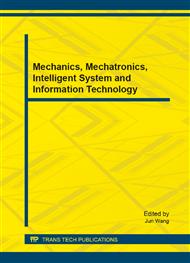[1]
P. Y. Chen, T. Pedersen, Bak-Jensen B, et al. Arima-based time series model of stochastic wind power generation, J. IEEE Journals and Magazines, 2010, 25(2), pp.667-676.
DOI: 10.1109/tpwrs.2009.2033277
Google Scholar
[2]
Z. W. Chen, P. Wang, Research and improvement of the network traffic prediction based on FARIMA model, Computer Technology and Development, 2010, 12(20) , pp.54-56.
Google Scholar
[3]
B. Deng, J. Li, T. Sun, J. S. Zhang, Traffic prediction based on neural network, Journal of Chengdu university of information technology, 2008, 23 (5) , pp.518-521.
Google Scholar
[4]
Y. N. Zhang, B. L. Liu, W. T. Wang, Neural network based on traffic prediction model of customer service center, Journal of Jilin University(Information Science Edition), 2011, 29(2), pp.97-101.
Google Scholar
[5]
MOU Ying, WANG Junfeng, XIE Chuanliu, XIA Zhenghong, Forecast on traffic of large call center, Computer engineering and design, 2010, 31(21): pp.4686-4689.
Google Scholar
[6]
Ehab E. Elattar, John (Yannis) Goulermas, Q.H. Wu, Electric Load forecasting based on locally weighted support vector regression, IEEE Transaction On Systems, Man And Cybernetics—Part C: Applications And Reviews, 2010, 40(4), pp.438-447.
DOI: 10.1109/tsmcc.2010.2040176
Google Scholar
[7]
R. Han, Z. H. Jia, Traffic forecasting based on SVR with differential evolution strategy, Computer engineering, 2011, 1(2), pp.178-180.
Google Scholar
[8]
Bermolen P, Rossi D. Support vector regression for link load prediction. J. Computer Networks, 2009, 53(2), pp.191-201.
DOI: 10.1016/j.comnet.2008.09.018
Google Scholar
[9]
X. Q. Shao, X. M. Ma, Modeling and simulation of chaotic time series prediction, Computer Simulation, 2011, 5(28), pp.228-231.
Google Scholar
[10]
W. L. Li, Y. X. Li, Least square support vector machines model based on particle swarm optimization for hydrological forecasting, Journal of computer applications, 2012, 32(4), pp.1188-1190.
DOI: 10.3724/sp.j.1087.2012.01188
Google Scholar
[11]
Shensa M J. The Discrete wavelet transform: wedding the Trous and Mallat algorithms. IEEE Transactions on Signal Processing, 1992, 40(10), pp.2464-2482.
DOI: 10.1109/78.157290
Google Scholar
[12]
X. T. Chen, J. X. Liu, Network traffic prediction based on wavelet transformation and FARIIMA, Journal of communication, 2011, 4(32), pp.153-157.
Google Scholar
[13]
H. L. Feng, Y. Liu, Network traffic prediction based on wavelet analysis and AR-LSSVM, Computer Engineering and Applications, 2011, 47(20), pp.88-90.
Google Scholar
[14]
X. L. Zhou, W. L. Wang, W. J. Chen, Network traffic prediction model based on wavelet transform and optimized support vector machine, Computer applications and software, 2011, 2(28), pp.34-37.
Google Scholar


